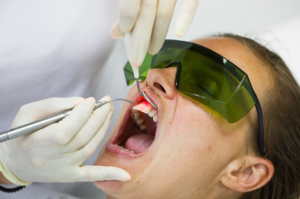The use of lasers in dentistry have not only changed the experience for the patient, but it also has had an effect on how dentist work.
Like other forms of technology, dental laser technology is constantly changing and evolving.

What Are Lasers?
According to an RDH magazine article, “a laser is a nondivergent, man-made, monochromatic, electromagnetic energy of one wavelength. It is a single color of light (monochromatic). Laser light is produced when an atom becomes excited, thus emitting a photon which is the elementary particle responsible for electromagnetic phenomena. The photon, as we learned in radiology class, is the carrier of electromagnetic radiation of all wavelengths. This photon then produces the coherent, focused, concentrated ray of light.”
The same article notes that how effective a laser is in treating dental issues are the result of what the laser’s wavelength is, where it falls on the light spectrum and what type of tissue the laser is to target.
How Lasers Change How Dentists Work
The use of lasers in dentistry is no longer optional, but required and expected.
This creates more work for the dentist and their staff because they now must stay up on current dental laser technology to provide the highest standard of care for their patients.
Lasers in dentistry have come a long way since they began being used in 2008. Now there are different lasers for soft and hard tissue. Each of these lasers have different wavelengths and fall on different places on the light spectrum.
Lasers are a significant investment for a dental office. When researching lasers, dentists need to decide which ones will best treat their patients. Understandably, many dentists are reluctant to invest in laser technology that is new and doesn’t have ADA endorsement or substantial science and medical support.
When dentist do decide on a laser to invest in, they and their staff must become familiar and sufficient with properly using it. While there are numerous benefits to using lasers when they are properly handled, they can provide insufficient or ineffective treatment, make the dental office less efficient and cause pain (namely burns) and discomfort for the patient.
The rapidly changing nature of dental lasers often means dentists must always be learning and adapting.
The Benefits of Lasers in Dentistry for the Patient
Dental lasers have become the new standard because of the great benefits it provides patients. The most notable benefits include:
- Less post-op discomfort
- Improved bleeding indices
- Better tissue contouring and coloring
- Faster tooth reattachment
- Quicker and more effective treatment
- Lower dental office costs, which result in reduced amount dentists charge for their services
For the patient, laser dental treatment yields a positive dental office experience. More complex dental procedures of the past are now quick, painless, routine procedures that can be done in one office visit. Laser also lower the discomfort and occurrence of post-procedure soreness, bleeding and sensitivity.
Lasers also reduce the cost of dental procedures by reducing the amount of tools, equipment and anesthesia required for the dentist to perform a procedure.
The treatment of dental lasers is more effective and accurate, reducing the possibility of an infection or recurrence of a dental issue and cuts down the recovery time, which will also lead to patients saving money on dental expenses.
Common Dental Issues Treated With Lasers
Dental laser treatment is most commonly found when a dentist is performing a scaling and root planing procedure (SRP).
Other common dental procedures that are made easier with lasers include:
- Sealants for tooth pits and fissures
- Complement scaling and root planing procedures
- Aphthous ulcer treatment
- Whitening
- Decay prevention
Other dental applications for lasers include:
- Pre-rinse with antimicrobial mouth rinse
- Anesthesia as needed
- Ultrasonic instrumentation
- Hand instrumentation
- Bacterial reduction
If you’re a dentist, your practice can’t afford to be left behind when it comes to using laser technology. Your patients demand and expect you to stay up on current dental treatments and technology so they can have the best dental experience and treatment.
Investing time and financial resources into laser dental technology are the biggest risks you’ll face, but they are beneficial to your patients.
At Arrowhead Dental Laboratory, we’re committed to the success of your dental practice. We offer a variety of continuing education, including those on dental technology.
For more information about the resources we provide to your dental office, contact us today.
